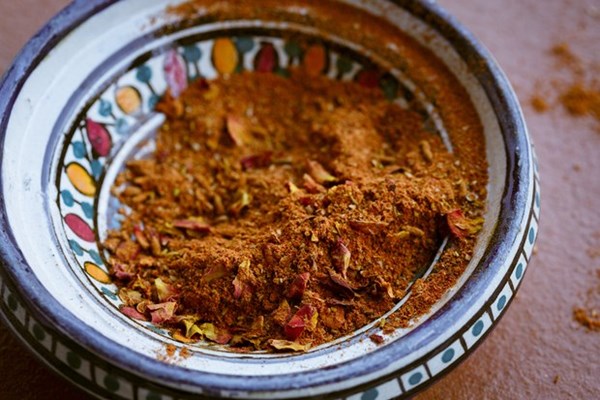Spice support: ras el hanout
February 24, 2019 by DarcieOver the centuries, signature spice blends have been developed in regions the world over. Most of these blends started with combining herbs and spices that grew in the local area, but after the development of the spice trade routes, people began incorporating flavors from farther away into the blends. One blend that has garnered a following far outside of its original area is ras el hanout, which hails from North Africa.

According to the Encyclopedia of Spices and Herbs, Ras means king, and the name of the spice blend is often translated as “head of the shop.” As with many blends, there is no single recipe that is definitive, with everyone adding or subtracting items to suit their personal preferences, with spice vendors closely guarding their particular combination. Typical components of ras el hanout include coriander, green cardamom, black pepper, cinnamon, ginger, turmeric, cumin, anise, and fennel seeds. Rose petals or lavender blossoms are also frequently included.
The spice blend is used to season dishes ranging from couscous and rice to tagines, soups and stews. You can use it as a dry rub on meats as well. You can make your own ras el hanout, which is traditionally sold as a blend of whole spices that are ground just prior to use. The EYB Library contains several recipes for making your own blend, including the Moroccan spice blend (Ras-el-hanout) from Epicurious pictured above. And of course, the Library contains hundreds of recipes that use ras el hanout, like these Member favorites:
- Moroccan lentil soup from Leite’s Culinaria by Diana Henry
- Dorie Greenspan’s sheet pan chicken with apples and kale from Everyday Dorie at The Washington Post
- Watercress & chickpea soup with rose water & ras el hanout from Jerusalem by Yotam Ottolenghi and Sami Tamimi
- Chicken tagine with pomegranate tabbouleh from BBC Food by James Martin
- Kofta with yogurt-tahini sauce by David Lebovitz and Elizabeth Prueitt and Chad Robertson
Categories
- All Posts (6940)
- Antipasto (2135)
- Author Articles (247)
- Book News (935)
- Cookbook Giveaways (983)
- Cookbook Lovers (257)
- Cooking Tips (109)
- Culinary News (299)
- Food Biz People (552)
- Food Online (791)
- Holidays & Celebrations (272)
- New Cookbooks (149)
- Recipes (1500)
- Shelf Life With Susie (231)
- What's New on EYB (133)
Archives
Latest Comments
- kmwyman on Rooza by Nadiya Hussain – Cookbook Review and Giveaway
- Maryd8822 on The Golden Wok – Cookbook Giveaway
- Dendav on Danube Cookbook Review and Giveaway
- sanfrannative on Rooza by Nadiya Hussain – Cookbook Review and Giveaway
- darty on Danube Cookbook Review and Giveaway
- Atroyer7 on Danube Cookbook Review and Giveaway
- demomcook on What foods do you look forward to the most for each season?
- demomcook on Danube Cookbook Review and Giveaway
- Darcie on How cookbooks can help build resilience
- mholson3 on Danube Cookbook Review and Giveaway